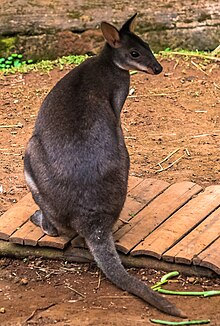| Dusky pademelon | |
|---|---|

| |
| Dusky pademelon in Taman Safari Bogor | |
| Conservation status | |
 Vulnerable (IUCN 3.1) | |
| Scientific classification | |
| Domain: | Eukaryota |
| Kingdom: | Animalia |
| Phylum: | Chordata |
| Class: | Mammalia |
| Infraclass: | Marsupialia |
| Order: | Diprotodontia |
| Family: | Macropodidae |
| Genus: | Thylogale |
| Species: | T. brunii |
| Binomial name | |
| Thylogale brunii (Schreber, 1778) | |

| |
| Dusky Pademelon range (brown — extant, orange — possibly extinct) | |
The dusky pademelon or dusky wallaby (Thylogale brunii) is a species of marsupial in the family Macropodidae. It is found in the Aru and Kai islands and the Trans-Fly savanna and grasslands ecoregion of New Guinea. Its natural habitats are subtropical or tropical dry forests, dry savanna, subtropical or tropical dry shrubland, and subtropical or tropical dry lowland grassland. It is threatened by habitat loss.
Names
The scientific name of this pademelon honors Cornelis de Bruijn, the Dutch painter who first described it in the second volume of his Travels, originally published in 1711. There de Bruijn labeled his description with a common name then current, philander ("friend of man"). A later common name was the Aru Island wallaby.
It is known as kutwal (or kotwal) in the Kalam language of Papua New Guinea. François Valentyn records that Aru Islanders call it aijir and pelandoe; the Malays call it pelandok-aru ("Aru mousedeer") while the Ambonese call it koeskoes-aroe ("Aru cuscus") because it has a pouch like said animal.
References
- Groves, C. P. (2005). Wilson, D. E.; Reeder, D. M. (eds.). Mammal Species of the World: A Taxonomic and Geographic Reference (3rd ed.). Baltimore: Johns Hopkins University Press. p. 69. ISBN 0-801-88221-4. OCLC 62265494.
- ^ Leary, T.; Seri, L.; Flannery, T.; Wright, D.; Hamilton, S.; Helgen, K.; Singadan, R.; Menzies, J.; Allison, A.; James, R. (2016). "Thylogale brunii". IUCN Red List of Threatened Species. 2016: e.T21870A21958826. doi:10.2305/IUCN.UK.2016-2.RLTS.T21870A21958826.en. Retrieved 12 November 2021.
- Livius.org on Cornelis de Bruijn Archived 2014-07-13 at the Wayback Machine, by Jona Lendering.
- Chisholm, Hugh, ed. (1911). "Filander" . Encyclopædia Britannica (11th ed.). Cambridge University Press.
- Pawley, Andrew and Ralph Bulmer. 2015. A Dictionary of Kalam with Ethnographic Notes. Canberra. Pacific Linguistics.
- van der Lith, P. A.; et al., eds. (1899). "Buideldieren". Encyclopædie van Nederlandsch-Indië. The Hague-Leiden: Martinus Nijhoff-E.J. Brill. p. 296.
External links
- "Filander" . Collier's New Encyclopedia. 1921.
| Taxon identifiers | |
|---|---|
| Thylogale brunii |
|
This article about a diprotodont is a stub. You can help Misplaced Pages by expanding it. |